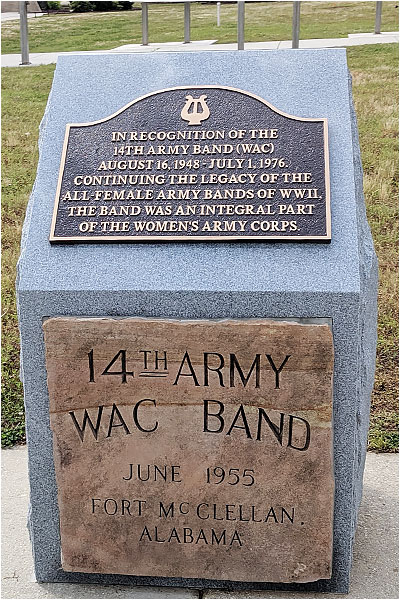US Army Women's Museum - Virtual Tour
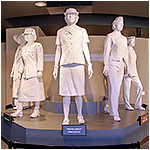
Welcome to the United States Army Women's Museum--where we celebrate women's history 365 days a year!
We are the only museum in the world dedicated to Army women. The Museum honors women's contributions to the Army from the Revolutionary War to the present, telling their stories with interactive exhibits and videos throughout the gallery. The museum also has an extensive research and learning center, and memorial garden.
We are excited to showcase the museum after an extensive gallery expansion and complete re-design in 2018; the museum opened with all new exhibits, to include a dedicated space to showcase the museum's art collection. The galleries contain fascinating artifacts, interactive displays and video presentations. Its modern look and feel provides a wonderful visitor experience. Through this virtual tour we hope you will have the opportunity to explore the exhibits, take a tour around the outside and visit the new Women at War outdoor exhibit and enjoy the beautiful reflection garden.

Welcome
The museum traces its roots back to the Women's Army Corps Museum at Fort McClellan, AL which opened in 1955. In 2001, the museum was relocated to Ft. Lee, VA, the site of the former WAC Training Center, and renamed the U.S. Army Women’s Museum, telling the full story of Army women from 1775 to the present. The museum reopened in November of 2018 after an extensive expansion and complete re-design of all its exhibits.
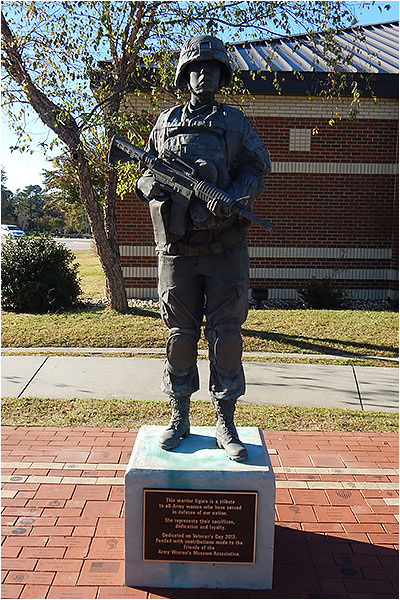
Lieutenant (1 Lt.) FAWMA
This warrior figure is a tribute to all Army women who have served in defense of our nation. She represents their sacrifices, dedication and loyalty. It was dedicated on Veteran’s Day 2013 and funded through generous donations to Friends of the Army Women’s Museum Association.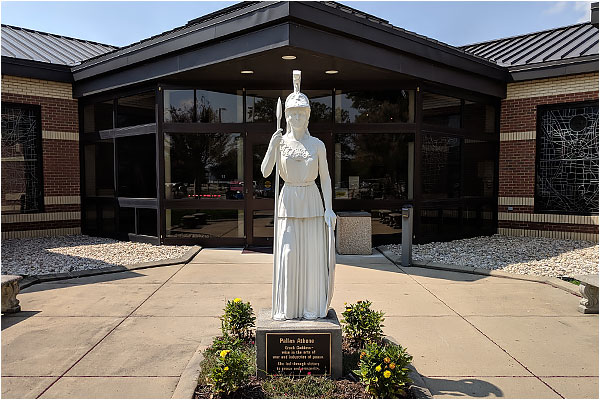
Pallas Athene
Pallas Athene: Greek Goddess – wise in the arts of war and industries of peace. She led through victory to peace and prosperity. Pallas Athene was the branch insignia worn by members of the Women’s Army Corps (WAC) from 1942 to 1978.
Museum Information
Upon entering, visitors will be greeted by friendly museum staff who will help them get started on their journey through Army women's history.
Rotating Gallery Space
The museum collects, preserves, manages, interprets and exhibits its unique artifacts and documents as a means to provide training and educational outreach. This space serves as a rotating exhibit area with new exhibits installed every year.Hours of Operation
Gallery Hours:Monday - Saturday: 10:00A - 5:00P
*Closed on Federal Holidays*
Training Support Hours:
Monday - Friday: 8:00A - 5:00P
Saturday: 10:00A - 5:00P
Educational Resource Center
The museum is an excellent resource for study and research, containing over 1.5 million documents pertaining to Army women within its archives. The archival collection spans from 1914 to present and is housed in various forms. We are actively collecting the stories of female Soldiers and DA civilians. We also conduct oral histories. Please call (804) 734-4327 for more information.
Museum Introduction
The museum is divided into five galleries, each sharing stories of how women have contributed to the U.S. Army at different points in time. Upon entering, five life sized figures greet the visitor, each one representing a different time period that is reflected in the galleries. The overarching theme addresses how and why the role of Army women changes over time.
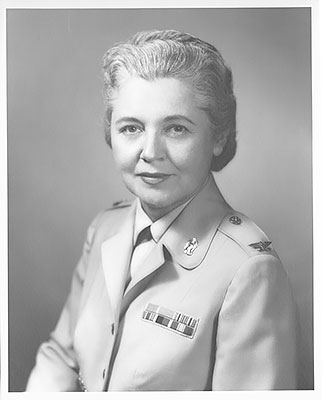
The Rasmuson Legacy
Mary Louise Rasmuson (nee Milligan) was born in Pittsburgh, PA in 1911. A University of Pittsburgh graduate, she joined the Women's Army Auxiliary Corps (WAAC) during World War II and became one of the first female officers graduating from Officer Candidate School in 1942. After the war, she worked her way up the ranks and was appointed Director of the Women's Army Corps in 1957. During her tenure as director Rasmuson was instrumental in increasing the strength of the WAC, for which she was awarded the Legion of Merit. She died in 2012 at the age of 101. This stained glass window, a copy of the original in the WAC Chapel at FT McClellan, AL, as well as many other items in the museum galleries, was made possible by a generous donation from the Rasmuson Foundation.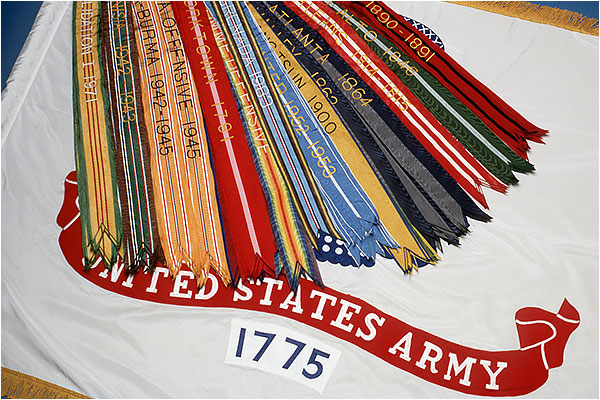
The Army Flag
The army’s storied past is represented by this U.S. Army flag with campaign streamers. Each of the 206 streamers tells the story of the army’s proud heritage, with a lineage stretching from the first shots fired for American independence at Lexington in 1775 to current operations in Afghanistan and Syria. The Army forged its identity with each streamer. As you can see, this is not only women’s history, but army history and therefore our nation’s history.Stepping Out
These five statues symbolize the history encompassed in our five main galleries. On the far left, a Revolutionary War camp follower represents the “Origins of Service” Gallery, which tells the story of Army women from 1775 through WWI. The next Soldier in line is a member of the Women’s Army Corps (WAC) during “World War II”, the topic of our second gallery. The third figure symbolizes the “Permanent Presence” Gallery which follows the story of the WAC from 1948-1978. The fourth figure represents the “Be All You Can Be” Army of the 1980’s and 90’s. The fifth and final figure embodies the continuing fighting spirit of the women of the “21st Century Army,” which follows Army women from the 9/11 terror attacks through the present.
Finding a Way to Serve
American women have always found unique ways to serve with the United States Army. In the American Revolution and during the Civil War women known as “camp followers” helped to provide basic needs, such as cooking and laundering, that the Army was unable to do for itself. Women also provided support in unconventional ways by stepping outside societal norms.
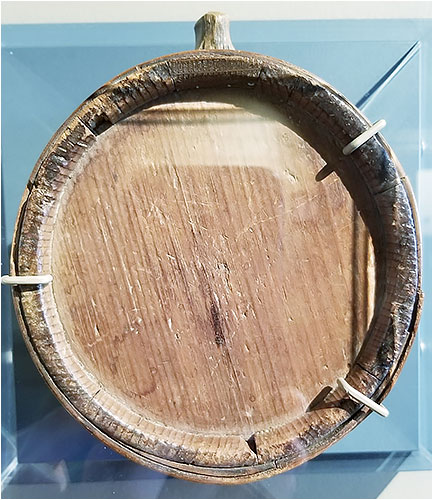
Revolutionary War Canteen
This is the type of canteen carried by Revolutionary War soldiers. Women served with the Continental Army from its inception in 1775, primarily in roles such as laundresses and cooks. While not in uniform, these women shared in the hardships of Army life during the Revolution. In some cases, a few courageous women such as Margaret Corbin found themselves on the battlefield. When her husband, John, was mortally wounded at the Battle of Fort Washington in 1776, Margaret took up his post and continued to fire his cannon on the battlefield. In 1779, Congress authorized a pension for Margaret, earning her the distinction of being the nation’s first servicewoman.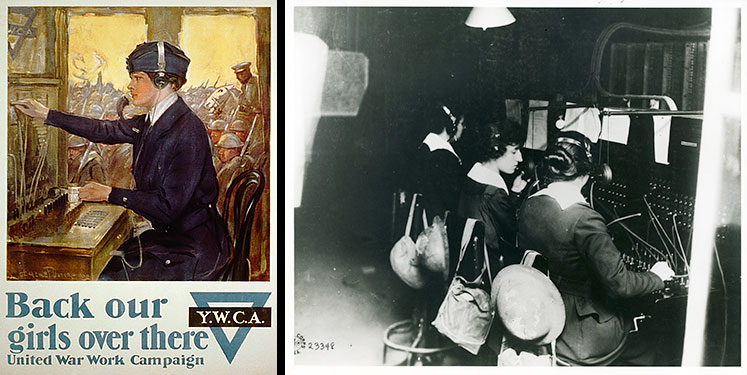
The “Hello Girls”
When the American Expeditionary Forces arrived in France, the commander General John J. Pershing quickly became frustrated with the customs and language of the native telephone operators the Army was using. He requested American bilingual switchboard operators be sent as soon as possible. In March 1918 the first Signal Corps Female Tele- phone Operators Unit arrived in France. They were colloquially nicknamed the “Hello Girls.” More than 7,000 women applied for the 450 positions needed!
Over There
Women’s roles in the Army were formalized and legitimized during the Great War. The formalization and legitimization of roles for women comes with the recognition of three areas of critical Army needs which became most evident in World War I: physical health of Soldiers, their morale & welfare, and skilled labor in the military and private sector.
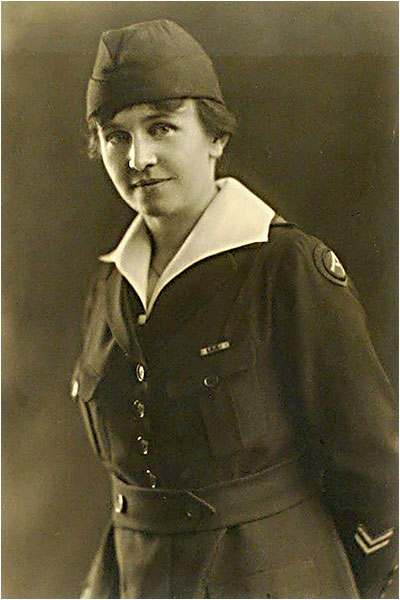
Army Nurse at Home and Abroad
Ruth Lyeth (Hamblen) c. 1918. This nurse’s uniform was worn by Ruth Lyeth (Hamblen) during World War I. She served at Camp Meade, Maryland, before being sent to Evacuation Hospital No. 30 in Meaux, France and then to Germany after the war. She returned to the U.S. in 1919.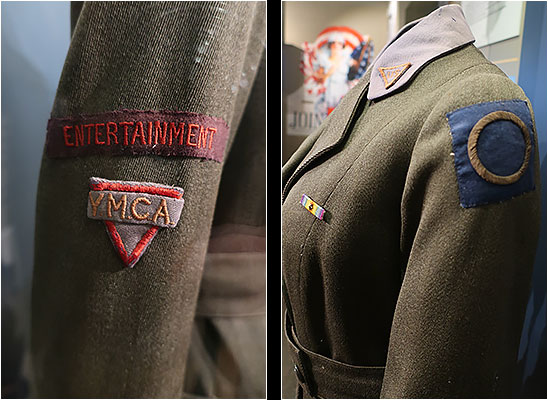
Helen Coates’ YMCA Uniform
This WWI YMCA uniform belonged to Helen Coates of Wausau, Wisconsin. Coates spent eight months in the Entertainment Service of the YMCA, utilizing her talents as a violinist to play for the doughboys serving in France. She would play two or three violin concerts per day in any available venue from posh hotels, farmer’s barns to American battleships. The uniform was designed by Mrs. Theodore Roosevelt, Jr. and cost a hefty $125.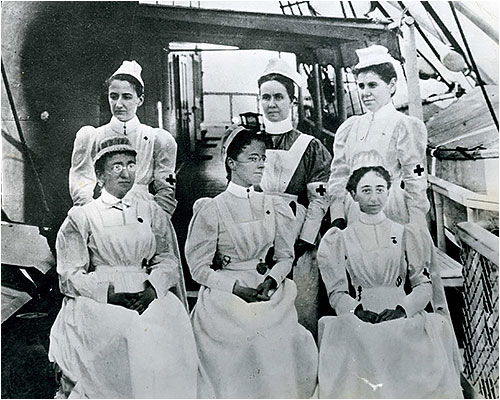
Establishment of the Army Nurse Corps
Since 1775, women have cared for the sick and wounded. In the American Revolution, the Continental Congress mandated one nurse for every ten patients and a matron for every one hundred. In the Civil War nearly 10,000 women provided medical care under the supervision of Dorthea Dix, the Superintendent of Female Nurses. During the Spanish-American War, nurses were called upon in support of troops stricken with dreaded tropical diseases. By 1901, the Medical Department acknowledged the need for a more permanent presence of nurses and created the Army Nurse Corps (ANC).
Caring for the Sick and Wounded
As World War I was nearing an end, a deadly virus spread across the world. In a mere two years, one fifth of the world’s population was infected—as many as forty million people. Army nurses, doctors, and various other medical staff bravely faced the dangers inherent in caring for infected military personnel.
Passage of the 19th Amendment
The dedicated service of women during World War I helped convince President Woodrow Wilson to support the Nineteenth Amendment which granted American women the right to vote. Although this was a significant gain, many of the women who served during the war never received formal recognition for their work. This injustice was noted by Congresswoman Edith Nourse Rogers, who vowed that if women were to serve again, they would do so with the same rights and privileges as men. Her resolve set the stage for the change to come with World War II.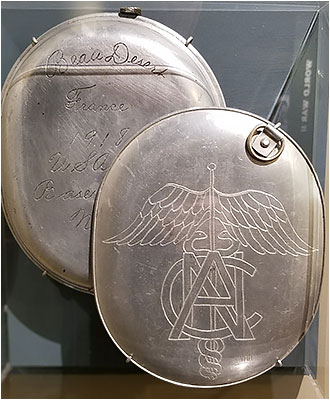
M1910 Meat Pan
Army Nurse Minnie McEwan, assigned to Base Hospital No. 22, used this Army M1910 Meat Pan while serving in France during World War I. While overseas, the Army Nurse Corps symbol, her name, hospital unit and location were carved onto the meat pan. Creating “trench art” was a popular activity for those serving with the military. Interestingly, McEwan’s meat pan was found by the artifact’s donor while he was cleaning an old barn in Payson, AZ.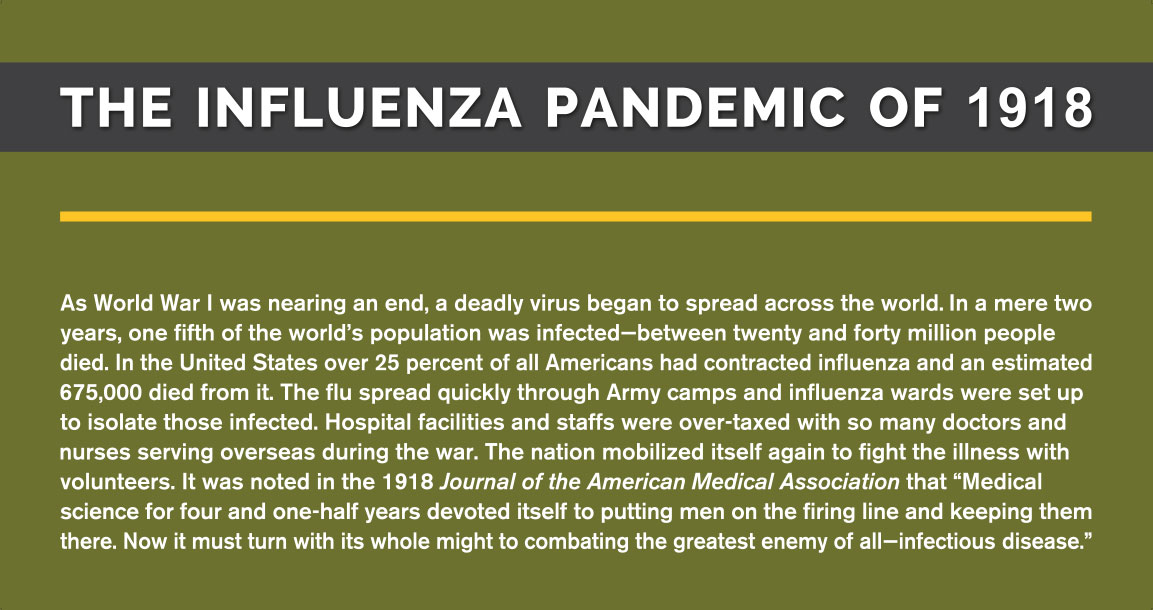
Sickness Everywhere

Free a Man to Fight
A separate Army corps for women was established during WWII in response to manpower shortages. After great debate over its proposal, the Women's Army Corps (WAC) was established to "free a man to fight." Their capabilities, skills and dedication quickly exceeded expectations and the corps, commanded by COL Oveta Culp Hobby, grew exponentially. Ultimately, over 200,000 women served around the world in the WAC and the Army Nurse Corps during WWII; their contributions forever changed the Army and the nation.
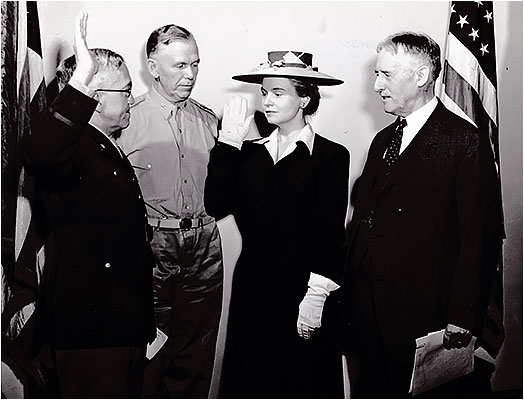
Oveta Culp Hobby
When the WAAC bill was signed into law, Oveta Culp Hobby was appointed Director of the Women’s Army Auxiliary Corps. Hobby was highly qualified with years of experi- ence as the editor of a Houston newspaper, chief of the Women’s Interest section in the Public Relations Bureau at the War Department, and the wife of a former Texas governor. She had a proven record of achievement but also femininity and grace that would appeal to small town and middle class America. Col. Hobby’s devotion to the Corps was evident in her insistence that she be allowed to enroll in the first Officer Can- didate class so that she could personally understand the challenge for women adjusting to military training. She pursued this through several levels of command and only ac- cepted “no” when General Marshall told her that this was not appropriate due to the Army rank system! She spent four long years putting together a women's Army like none other.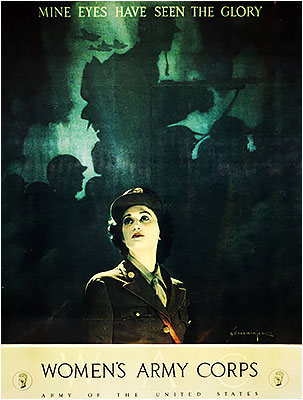
Women’s Army Auxiliary Corps
In the years between the world wars, several concepts for a women’s army corps were discussed. It was not until after the attack on Pearl Harbor in December 1941 that serious consideration was given to the plan. Public and military sentiment swung in favor of the creation of the Women’s Army Auxiliary Corps (WAAC) but only to last the duration of the war plus six months. The first WAAC director was Col. Oveta Culp Hobby of Texas.
Women's Airforce Service Pilots
The WASP, or Women’s Air Force Service Pilots, was a program that enabled civilian women with pilot licenses to support the Army Air Forces by ferrying planes from factories to airfields and to train male pilots for combat. Over 1,000 WASPs served and nearly 40 were killed in the line of duty.
The Slander Campaign
During World War II the idea of bringing women into the Army was highly controversial, which explains why the WAC was initially slated to be abolished six months after the conclusion of the war. Contemporary political cartoons highlighted this controversy. A slander campaign was launched almost immediately after the WAC was established in an attempt to disparage the reputation of any woman who wanted to join. The attack came from within Congress and the public, from both men and women.See More Editorial Cartoons
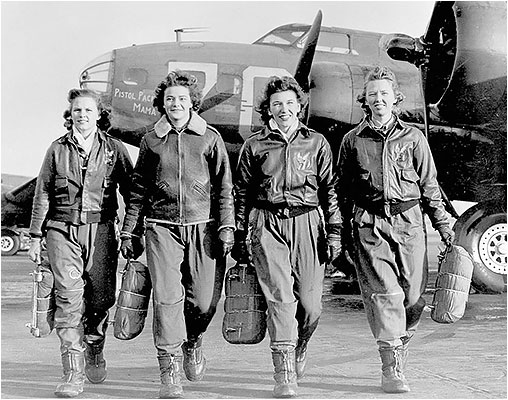
The WASP
The Army’s severe shortage of pilots in 1942 prompted the creation of the Women’s Airforce Service Pilots, or WASP. Led by Nancy Love and Jacqueline Cochran, more than 1,000 female volunteers flew every type of aircraft in the Army’s fleet. These women delivered new planes from factories to military bases, tested refurbished planes, towed targets for anti-aircraft gunnery practice, flew searchlight tracking missions, and instructed male pilot cadets. This dangerous work resulted in the deaths of thirty-eight WASPs.
Women's Ingenuity
Not everything that Army women needed or wanted was issued. They found themselves stationed all over the world, sometimes in austere conditions without the right clothing and without the comforts of home.
Women’s Ingenuity
Not everything that Army women needed or wanted was issued. The first class of recruits at Fort De Moines, Iowa, had to wear men’s overcoats through their first winter because the quartermaster was initially ill-equipped to provide the necessary clothing in adequate quantities. Moreover, women found themselves stationed all over the world, sometimes in austere conditions without the right clothing and certainly without the comforts of home. Their ingenuity was ceaseless.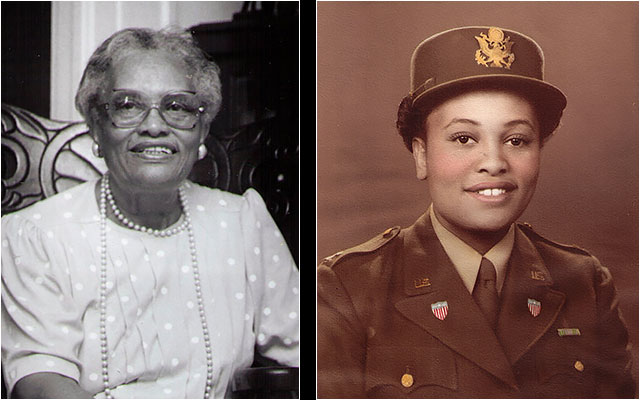
Dovey Roundtree
Dovey Roundtree was one of thirty-nine African American women who graduated from the First Women’s Army Auxiliary Corps Officer Candidate Class in August 1942.Listen to Her Story Portrayed by an Actress
See more images of Dovey Roundtree
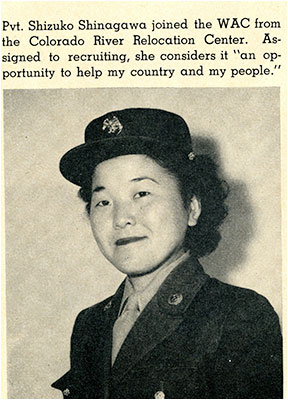
Nisei WACs
Beginning in 1943, the War Department recruited Japanese American women as linguists for work in cryptology and communications. Many came from Hawaii or directly from internment camps run by the War Relocation Authority. This photograph shows Nisei (Japanese-American) WACs beginning their journey to Tokyo in 1946. While there, they were discharged from the Army and continued to serve in a civilian capacity.
Going Where They Are Needed Most
In the summer of 1943 Army women were already working in 155 different Army jobs, and, were assigned to every major Army command in the United States and to the around the world.
Charity Adams and the 6888th
In February 1945, the 6888th Central Postal Directory Battalion became the only African American WAC unit to serve overseas. Over 800 Army women processed more than 130,000 letters, parcels, telegrams, and flat envelopes daily. Their unofficial motto was “No mail, low morale.” Their tireless efforts to deplete the backlog of undelivered mail boosted morale to all soldiers serving in the Army. The unit’s commanding officer, Charity Adams, was the first African American Army woman to attain the rank of lieutenant colonel.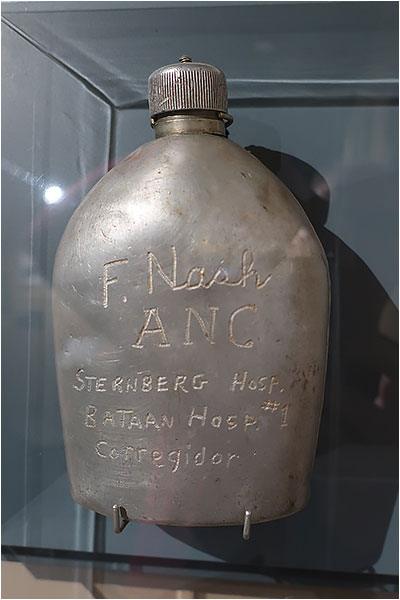
Lt. Frances Nash’s Canteen
This Model 1910 aluminum canteen was carried by Lt. Frances Nash, and Army nurse who served in the Philippines. One of the famous “Angels of Bataan,” Nash was captured by Japanese forces in 1942 and endured nearly three years in the infamous POW camp at Santo Tomas.
The Manhattan Project
More than 400 WACs worked in support roles for the research and creation of the atomic bomb at Oak Ridge, Tennessee; Los Alamos, New Mexico; and Pasco, Washington. The first ones reported for duty with the Manhattan District at Santa Fe, New Mexico, in April 1943. Women specialized in scientific and cryptographic techniques, metallurgy, and electronics. They worked twelve hour shifts, seven days a week under the utmost secrecy.
Serving with Pride and Dignity
With the passage of the Women’s Armed Services Integration Act in 1948, women were granted Regular Army and Army Reserve status solidifying their permanency in the Armed Forces. Although this new status came with challenges, an emphasis on image and professionalism helped ensure the longevity and success of their presence.
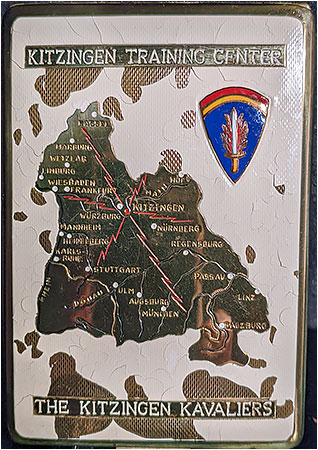
Harriet West Waddy’s Cigarette Case
At age 38, Harriet West Waddy was among the first African American officers commissioned in the Army in August of 1942. She attained the rank of major during World War II and after the war was one of the few black officers deployed overseas. Maj. West was the first WAC assigned to Kitzengen Basic Training Center, near Wurzburg, Germany as assistant post inspector. It was during this time that she bought the pictured cigarette case. The item was donated to the museum in 2000.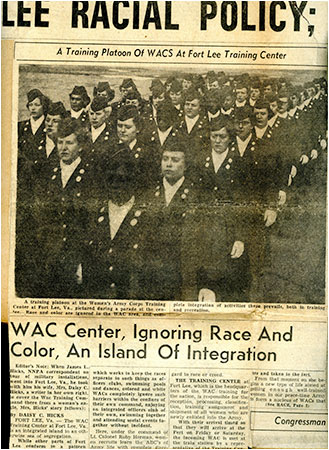
Island of Integration
Camp Lee, Virginia, was chosen as the training center for female enlisted and officer personnel in 1948. Approximately 30,000 WACs were trained there before it was moved to Ft. McClellan, Alabama. Also in 1948, President Harry Truman issued Executive Order 9981 declaring “there shall be equality of treatment and opportunity for all persons in the armed services without regard to race, color, religion, or national origin.” This policy was quickly adopted by the women at Camp/Fort Lee. By the early 1950s, the training center was described by newspapers as “an island of integration in an otherwise sea of segregation.” Women, regardless of race, were training, working, living and socializing side by side while the rest of society and even the military installation remained racially segregated.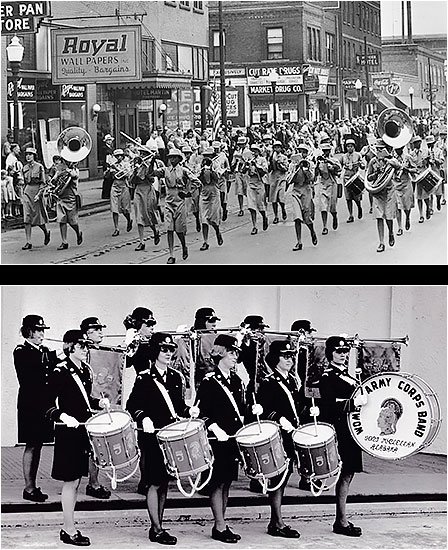
All Female Army Bands
Musicians are integral to the order, discipline, and morale of troops. There were five WAC bands in World War II that played for ceremonies at training bases, marched during parades in local communities, and welcomed home troops at the ports of embarkation. In 1948, the 14th Army Band (WAC) carried on the tradition as the only all-female band in the Army. It became the post band at Ft. McClellan in 1960 and integrated men in 1976. Women continue today to play an important role in Army bands and soldiers shows.Listen to The 14th Army Band
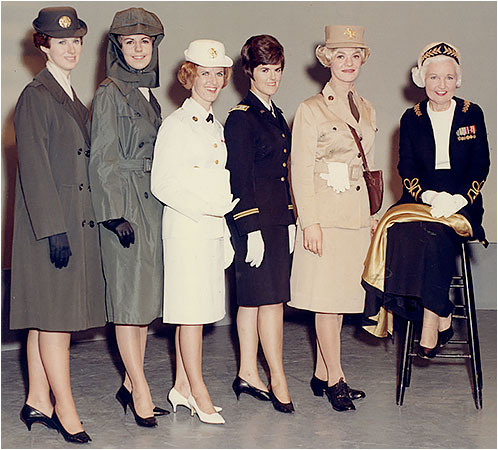
Changing Fashions
Uniforms were one of the primary ways in which the polished image of an Army woman was portrayed. The styles, designed by women for women, changed with the fashions of the time, some mirroring the look of male uniforms in color and cut and sometimes differing significantly by reflecting the most popular civilian styles. These photos show just a handful of the dozens of uniform changes for Army women from the 1950s – 1970s.See Photos of the Changing Fashions

With Achievement Comes…
Female service in Korea and Vietnam paved the way for the expanded opportunities that came at the end of the WAC era. During this period women would see barriers removed and inequalities eliminated as the Army focused on their training and utilization around the world.
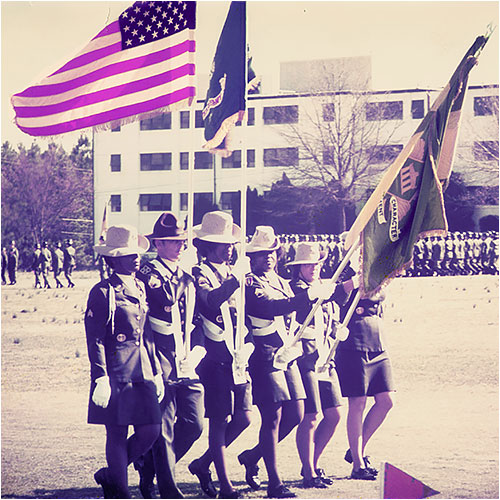
Drill Sergeant Hats
When the first group of women graduated from the Army’s drill sergeant school in 1972, they were issued the male drill sergeant hat, modeled after the World War I “campaign hat,” until a distinct female one could be designed and produced. The second group was given the new headgear, modeled after the “Australian bush hat.”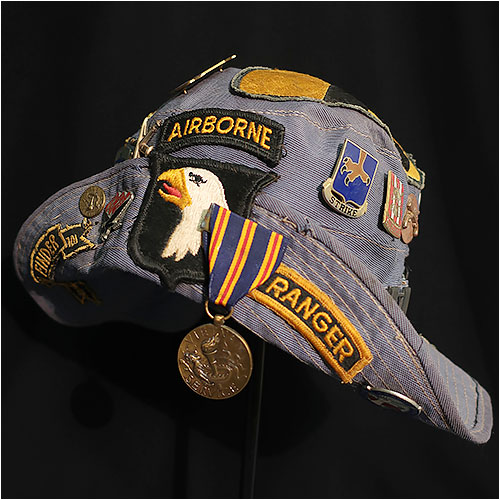
DA Civilian Hat
This hat was worn by Jan Neufeld in Vietnam from 1971-1972. She worked as a Department of the Army Civilian (DA) in Special Services (Morale, Welfare and Recreation). While in country she worked at two different "Serviceman Clubs" at Phu Bai and Vang Tau. Her duty uniform was a Blue Civilian dress with a matching blue "Boonie" Hat. While in Vietnam soldiers gave her their unit patches and assorted insignia which she attached to her hat.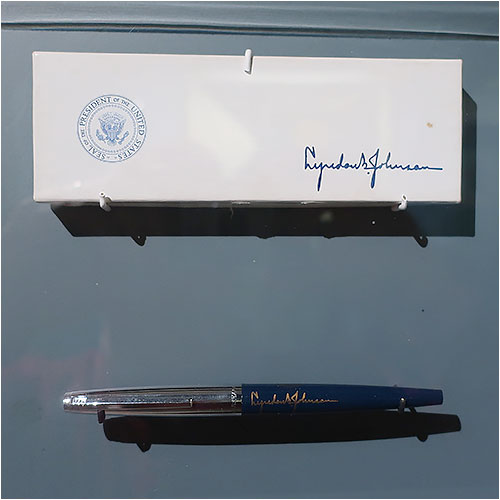
LBJs Pen
In 1967, President Lyndon B. Johnson signed Public Law 90-130 with this pen. The legislation eliminated restrictions on promotion and retirement for women in the armed forces. Within five years, 437 of the Army’s 485 military occupational specialties (MOSs) were opened to women, allowing them to serve in additional fields such as ammunition specialist, dog trainer, plumber, or quarryman. Combat arms branches, such as infantry and armor, remained closed to women until 2016.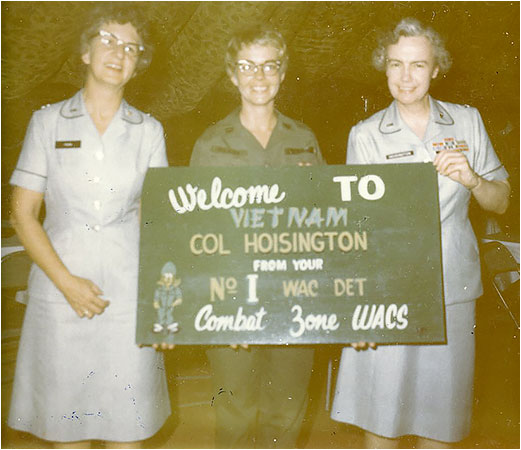
Handmade Sign
Over 8,000 Army nurses and almost 1,000 WACs served in Vietnam. For the latter, when they arrived in country they were wearing the Army Green cord uniform with black pumps, gloves, and a purse. After suffering miserably for several months in the hot and humid jungle climate, they were authorized by the commander of U.S. forces to wear fatigues and combat boots, much to the dismay of WAC director Col. Elizabeth Hoisington. Hoisington preferred that her Army women remained in the more feminine uniforms. This handmade sign was displayed in honor of Col. Hoisington’s visit to the WAC Detachment in Vietnam in 1967. Note the uniform the painted figure is wearing on the sign.
End of An Era
Changes to women’s roles both within the Army and in society, as well as the understanding that a separate corps was inefficient, ultimately led to the disestablishment of the WAC in 1978.
Disestablishment of the WAC
In 1978 the Women’s Army Corps was disestablished, increasing equal opportunities for women and ending inequalities based on gender for training, assignments, and promotions. It was the first step toward gender integration of the United States Army. Maj. Gen. Mary Clarke, the last director of the WAC and the first women to be promoted to major general, viewed the decision to end the WACs as “…the Army’s public commitment, not only to the men and women of the United States Army, but its commitment to the people of this nation to the total integration of women in the U.S. Army as equal partners.” She is pictured here with Command Sgt. Maj. Helen Johnson casing the colors of the Women’s Army Corps on the parade field at Ft. McClellan, AL on 21 March 1979.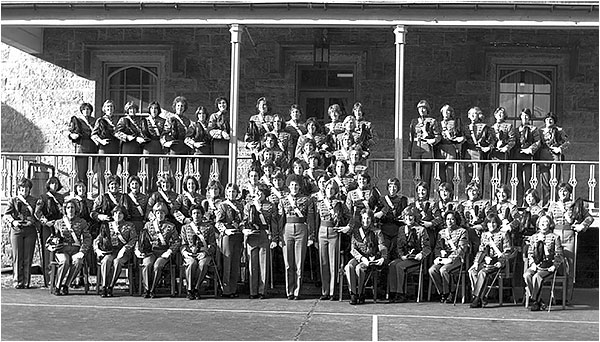
West Point Class of 1980
In 1975 President Gerald R. Ford signed a bill into law that allowed the admission of women into the service academies in the fall of 1976. When the first gender integrated class from West Point was commissioned into the Regular Army in 1980, they helped usher in an era of greater opportunities for women in training, assignments, and pro- motions.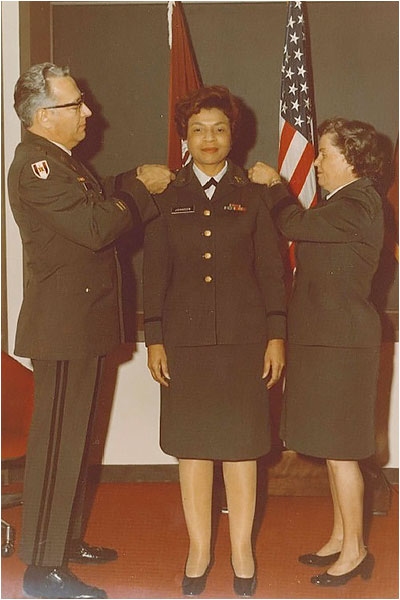
Hazel Winifred Johnson-Brown
Brig. Gen. Hazel Winifred Johnson-Brown was the 16th Chief of the Army Nurse Corps and the first African-American woman to attain general officer’s rank in U.S. Army history. She joined the Army in 1955, less than a decade after President Truman’s executive order that desegregated the U.S. military. She quickly rose through the ranks of the ANC and earned her PhD at the Catholic University of America, making her the first Chief of the Army Nurse Corps with a doctorate. After retiring in 1983, Johnson-Brown enjoyed a second career in academia, teaching at Georgetown University and George Mason University.
Professionalism
The “Be All You Can Be” Army of the 1980’s and 1990’s represented a period of great change and transition for women in uniform. The Army transitioned to an all-volunteer force and focused on professionalism and career opportunities for both women and men. The quality and value of Army women’s service was universally acknowledged and demonstrated that the force had successfully integrated women into its ranks.
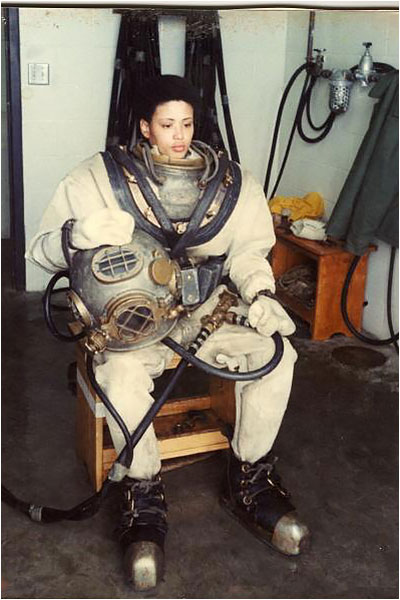
SGT Motley
In 1982 Sgt. Andrea Motley (Crabtree) became the first Army woman to graduate from the Second Class Diver Course. She completed an intensive Naval training program that had over a 70% attrition rate. She was assigned as a diver at the U.S. Army Petroleum Distribution System in Korea, where she and one other woman were forced to reclassify when the military occupational specialty (MOS) 00B (diver) was restricted to men only. It would be more than a decade before the field re-opened to women.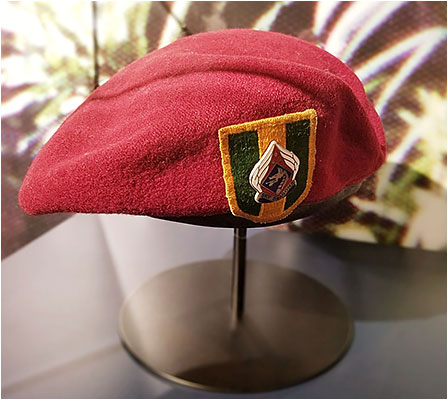
Marian Anderson’s Beret
In 1983, revolutionaries in the Caribbean nation of Grenada executed the civilian prime minister and instituted a military dictatorship, threatening the safety of approximately one thousand U.S. citizens. President Ronald Reagan authorized Operation Urgent Fury to neutralize the revolutionaries and reestablish a stable government. Four Army women were deployed with their military police but were promptly returned to their base at Fort Bragg, North Carolina due to a lack of clear policy governing women in a combat zone. Spec. Marian Anderson, whose beret is seen here, was one of the four. After a thirty-six hour debate between Congress and the administration, they were returned to Grenada and more than 100 women participated in the operation.
Mommy Goes to War
In the last two decades of the 20th Century, Army women found themselves serving around the world in multiple and varying types of operations as new career opportunities continually opened. Nevertheless, restrictions on women’s service remained and changing policies on the utilization of women during combat operations illustrated the Army’s effort to tackle never-before-faced challenges.
Gender Integrated Basic Training
The idea of men and women attending basic training together was first tested in 1975 at Fort Jackson, South Carolina, and implemented two years later. The plan was short-lived. The Army returned to gender separated basic training in 1982 upon complaints that men were not being sufficiently challenged physically. Ten years later, the question was re-visited when the Army began to open an increasing number of positions and specialties to women. After a feasibility study, it was decided in 1994 that men and women should train as they fight and gender-integrated training was reinstituted. Secretary of Defense William Perry reported that, “The research found no significant difference in training performance outcomes…the Army has recognized the importance of training male and female soldiers together as a cohesive team.”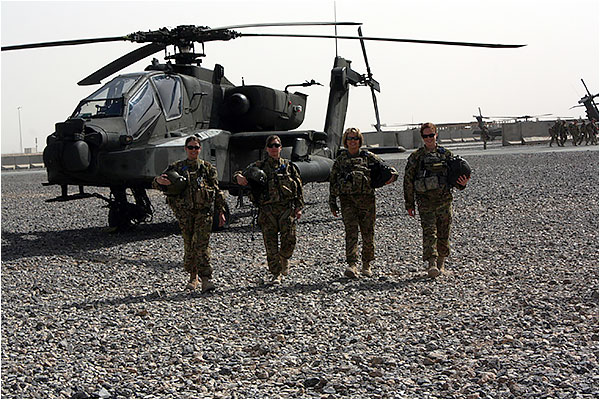
Female Helicopter Pilots
As the debate over women in combat continued in the early 90s, Secretary of Defense Les Aspin opened combat aviation to female pilots in 1993. Although women had begun flying Army rotary wing aircraft twenty years earlier, they were barred from assignments, and thus training, in aircraft such as attack helicopters. Enabling them to fly AH-1 Cobra and AH-64 Apache helicopters was a clear acknowledgement that the Army had confidence in a woman’s ability to perform in combat. In the modern Army, women are breaking new ground in the field of combat aviation. The helicopter pictured here is an OH-58 Kiowa.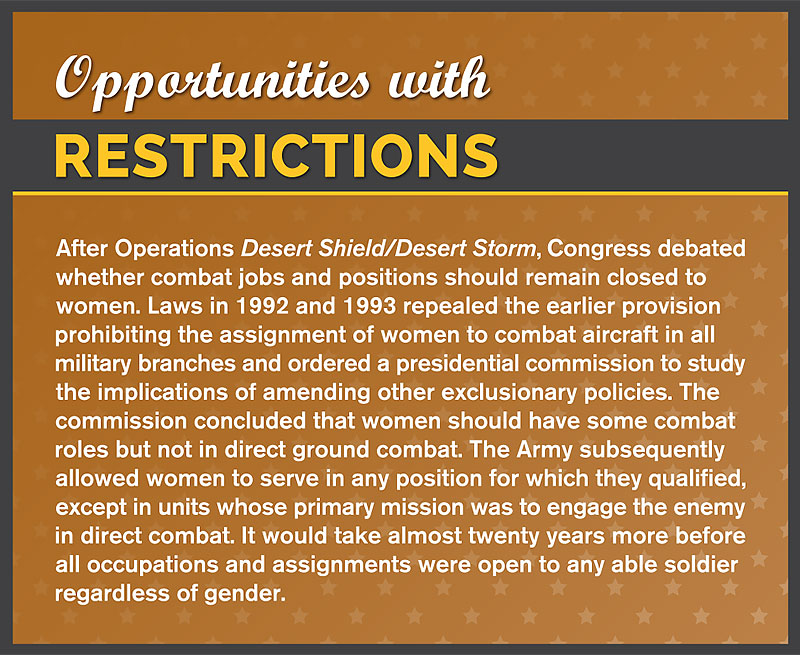
Opportunities
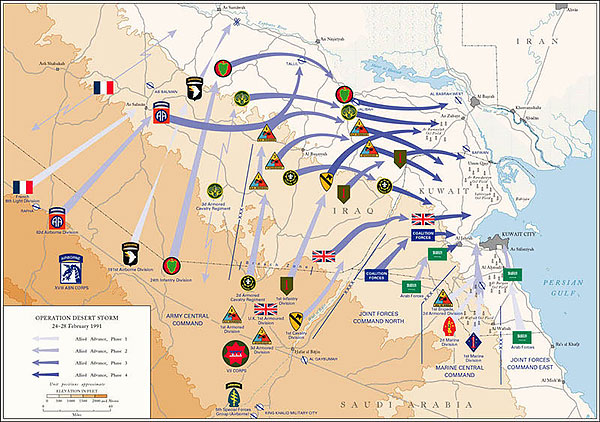
The First Gulf War
In the summer of 1990 Iraq invaded neighboring Kuwait to seize its valuable oil resources. The U.S. came to the aid of Kuwait with Operation Desert Shield, followed shortly thereafter with a United Nations response, Operation Desert Storm. In the largest call up of women since World War II, more than 24,000 Army women served in these operations. Fourteen women died and two were taken prisoner. With the mobilization of the Army Reserve and National Guard, which was 24% female at the time, the Army utilized women to their fullest potential. Military leaders acknowledged that excluding women from the mission would have impaired combat readiness. In 1994, the Direct Ground Combat Definition and Assignment Rule was put into effect, opening many positions to women, but clearly delineating where women could not serve in order to limit their exposure to hostile fire. The rule was rescinded in 2013.
Serving Around The World
Throughout the 1990s the U.S. Army deployed men and women around the world to support numerous contingency operations, some multi-national and others as part of larger United Nations (UN) or North Atlantic Treaty Organization (NATO) missions. Few people questioned whether or not women should be serving; the deployments solidified their presence regardless of the circumstance or location.
A Piece of the Pentagon
September 11, 2001 marked a pivotal changing point for the nation and the Army. Nearly 3,000 people were killed and 6,000 injured in the terrorist attacks at the World Trade Center, the Pentagon, and in western Pennsylvania. Subsequently, the nation engaged in a war on terrorism during which more than two million soldiers deployed. More than 255,000 were women and the debate over their roles in combat was again in the forefront. The artifact shown here is a fragment from the Pentagon façade that was damaged in the 9/11 attack. It was donated to the museum on the fifth anniversary of the attack.
Global War on Terror
The Army underwent a remarkable transformation in the early twenty-first century with the advent of the global war on terror. The modern battlefield blurred distinctions between rear and forward operating areas. This reality, combined with evolving cultural conditions, resulted in a profound transformation of roles for Army women.
Unsung Heroes
Visitors can view the 30-minute PBS documentary titled Unsung Heroes: The Story of America’s Female Patriots, which was produced with assistance from the museum staff. The film acknowledges and celebrates the more than 2.5 million women who have served in the U.S. military since the American Revolution through present day. For educational resources related to the film, or to view the full documentary, visit: www.unsungheroeseducation.com.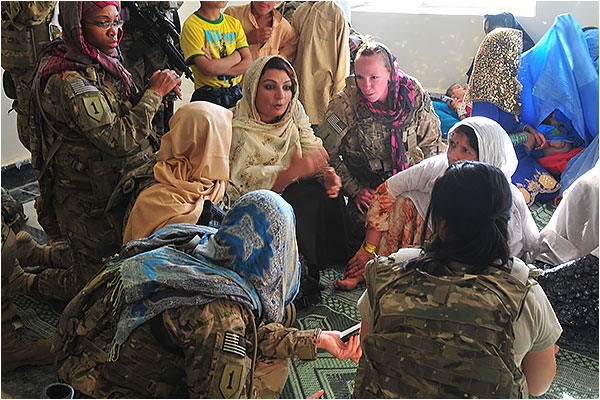
Female Engagement Teams
It became evident on the battlefields of Iraq and Afghanistan that female soldiers were needed for specialized work. Initially, women were attached to combat units to assist with missions involving women in the local population. Eventually, all-female teams were formed because cultural norms forbade male U.S. soldiers from approaching local women. Assignments for female engagement teams, cultural support teams and provincial reconstruction teams included medical outreach, community engagement, needs assessment, search and seizure, removal of threats, and information gathering. These groups built goodwill and confidence with local leaders and their work laid the foundation for extraordinary policy changes regarding assignment and utilization for all Army women.Dog Tag Tree
From the branches of this tree hangs an identification tag representing each female Army Soldier killed during combat operations since 11 September 2001. As of February 2018 the number is 126 soldiers.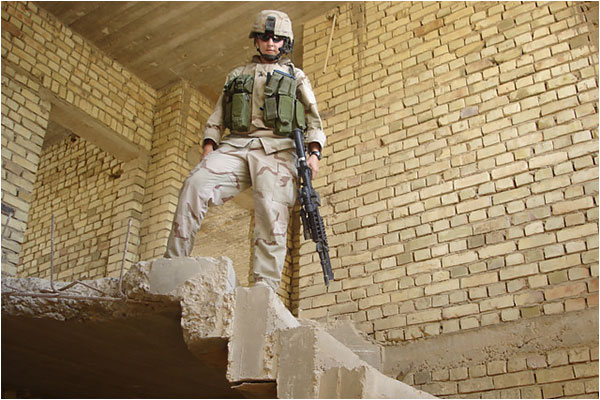
Leigh Ann Hester
Sgt. Leigh Ann Hester was awarded the Silver Star for her actions during an ambush that took place outside Baghdad in 2005. It was the first such medal awarded to a woman since World War II and the first recognizing that it was earned for direct combat action against an enemy.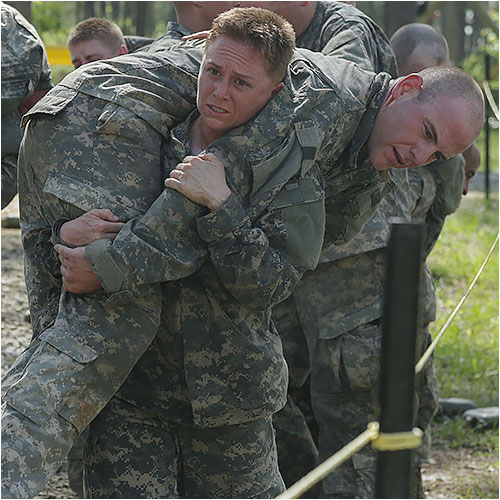
Ranger School
The realities of the battlefield and the recognized contributions of women to the Army’s success led to their unrestricted service. The carefully planned two year integration timeline called for a systematic approach to incorporating women into combat arms training and assignments. In 2016 all restrictions were lifted. They joined and trained in the infantry and armor branches and specialties previously closed to them in field artillery. In 2015, the first Army women were sent to Army Ranger School, where they successfully graduated. Seen here, a female Ranger candidate is carrying a fellow candidate on the obstacle course at Fort Benning, Georgia.
Army Strong
As women repeatedly demonstrated their skills and willingness to serve wherever needed, the Army moved to eliminate all unnecessary gender-based barriers to service. A measured and deliberate movement towards a standards based system was adopted, and the emphasis was placed in selecting the best soldier for the job. In a parallel effort, the Army embraced efforts to rescind other exclusionary policies while caring for and retaining its premiere 21st century fighting force.
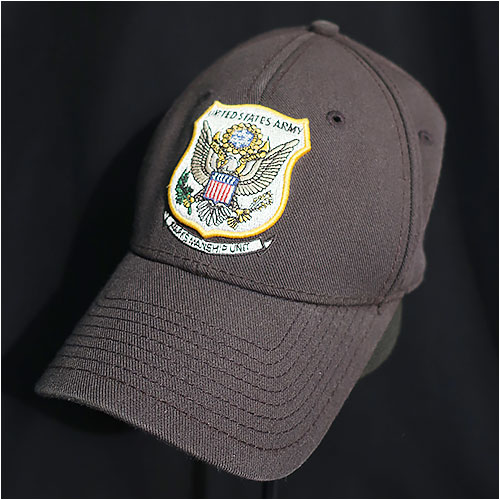
Sherri Gallagher’s Marksmanship Hat
Each year the Best Warrior Competition recognizes soldiers who demonstrate commitment to the Army values, embody the warrior ethos, and represent the force of the future. In 2010 Sgt. Sherri Gallagher became the first woman to earn the coveted title of Best Warrior. This black cap was worn by Sgt. Gallagher while serving as a sharpshooter with the US Army Marksmanship Unit and competing across the globe in rifle shooting events from 2009-2010.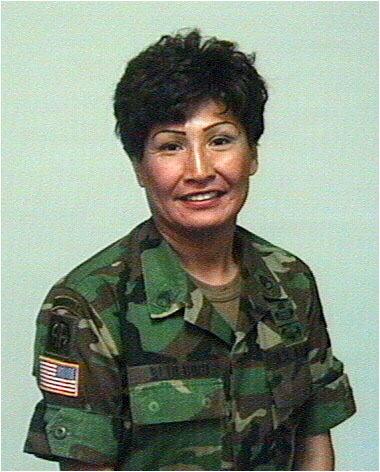
Sgt. Theresa Blue Bird
American communities realized that a modern deployment meant danger, separation, and sacrifice for all service members. Staff Sgt. Theresa Blue Bird deployed in support of Operation Iraqi Freedom with Task Force All-American. After her deployment, she was assigned to Fort Bragg, North Carolina., where she served as the Food Service Sergeant for the Headquarters and Headquarters Company, 82d Paratrooper Support Battalion, from 2002 until her retirement in 2004. She was later presented with this Sioux warrior’s quilted blanket, a tradition passed through generations, to recognize a tribe member’s participation in combat; she is the first woman from the Lakota tribe to have honorably completed twenty continuous years of active duty Army service.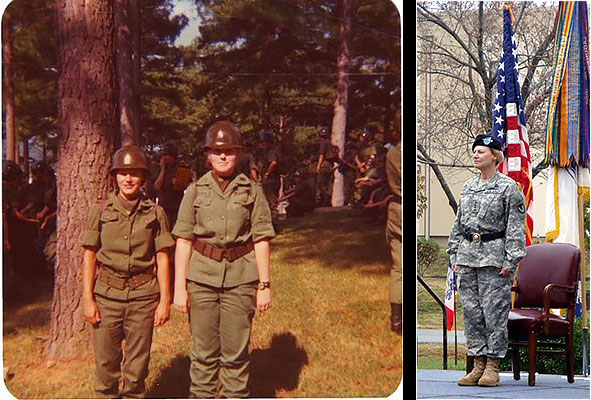
Gen. Ann Dunwoody
In 2008, Gen. Ann E. Dunwoody became the first woman in the history of the United States Armed Forces to achieve the rank of four-star general she came from a family with four generations of West Point graduates, but when she decided to join the Army, the U.S. Military Academy was closed to women. Instead, she went to college at the State University of New York in Courtland and entered the Junior College Program of the Women’s Army Corps. Through that program she went to WAC officer training for four weeks in the summer and was then commissioned a second lieutenant in 1975.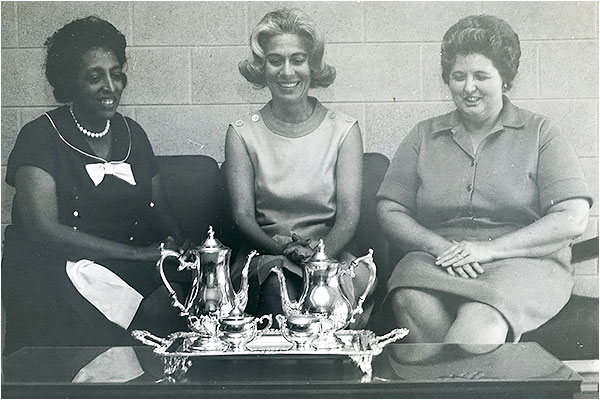
Army Spouses
Military spouses are a loyal, dedicated force that supports the defense of our nation with little reward or recognition. The Continental Army’s first “first wife,” Martha Washington, said “the greater part of our happiness or misery depends on our dispositions and not our circumstances.” Spouses have taken care of the home front – raising children, taking care of parents, and managing the day to day activities of their households. Through the span of their spouse’s Army career, wives and husbands have endured moving from one post to the next often more than a dozen times. Home is Where the Army Sends You is often seen hanging in the family’s quarters. Spouses of the senior commissioned and noncommissioned officer in a unit are expected to be at the ready to assist other families and their responsibilities grow as do those of their husband or wife in command. Many have professional careers at the same time. Where ever and whenever they are needed spouses contribute to the Army’s successes. Their dedication and tireless efforts have made the U.S. Army an unequaled fighting force.See a Photo Gallery
A Stronger Force
After more than a decade of war in Iraq and Afghanistan, the Army adopted more inclusive poli- cies that sought to match the best soldier to the job regardless of gender. It also instituted other changes in an effort to support military families, improve retention, and strengthen the force of the future. In 2009 the Army launched its Sexual Harassment/Assault Response and Prevention program (SHARP) to combat sexual assault and harassment in its ranks. In 2010 the President signed legislation that led to the repeal of “Don’t Ask Don’t Tell,” a policy that barred gay and les- bian service members from openly sharing their sexual orientation. In 2016 the Female Veteran Suicide Prevention Act was signed into law in response to alarming findings that women veterans were nearly six times as likely as non-veteran women to commit suicide. Also, the length of ap- proved maternity leave was doubled to twelve weeks That same year the DOD ended the ban on transgender Americans serving in the military.See a Photo Gallery

Outdoor Exhibit and Reflection Garden
Experience the museum's beautiful reflection garden with benches for visitors to enjoy the landscaped grounds. Read the ten panels about "Women at War” and visit the 14th WAC Band monument and memorial plaques.
Women at War
These ten panels offer concise vignettes about women’s service with the Army by highlighting their participation in every major American conflict since the Revolution. Original prints and photos from the museum’s vast archive give unique insights into the countless women who have gone to war since the days of Washington.